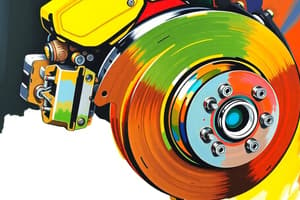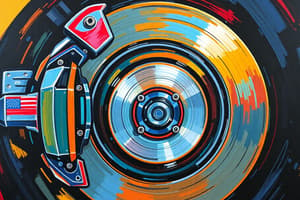Podcast
Questions and Answers
What is the primary function of automotive brakes?
What is the primary function of automotive brakes?
- To convert kinetic energy into heat and slow down the vehicle (correct)
- To increase friction on the tires
- To accelerate the vehicle
- To stabilize the vehicle on slopes
Braking systems are only mechanical devices and do not use hydraulic components.
Braking systems are only mechanical devices and do not use hydraulic components.
False (B)
What type of energy does the braking system convert the vehicle's kinetic energy into?
What type of energy does the braking system convert the vehicle's kinetic energy into?
heat energy
The brake pads are pressed against the _______ to create friction.
The brake pads are pressed against the _______ to create friction.
Match the following braking system components with their functions:
Match the following braking system components with their functions:
What is the effect of static friction when a vehicle comes to a stop?
What is the effect of static friction when a vehicle comes to a stop?
Friction between the tires and the road surface does not affect the speed of the vehicle.
Friction between the tires and the road surface does not affect the speed of the vehicle.
What factors affect the amount of resistance or friction in a braking system?
What factors affect the amount of resistance or friction in a braking system?
What is the primary function of the brake servo?
What is the primary function of the brake servo?
Disc brakes are typically used on both the front and rear wheels of passenger cars.
Disc brakes are typically used on both the front and rear wheels of passenger cars.
What initiates the hydraulic pressure in the brake main center?
What initiates the hydraulic pressure in the brake main center?
The _________ brake mechanism is typically used on the rear wheels of commercial vehicles.
The _________ brake mechanism is typically used on the rear wheels of commercial vehicles.
Match the brake components with their respective functions:
Match the brake components with their respective functions:
What is the role of brake fluid in the braking system?
What is the role of brake fluid in the braking system?
The pushing movement initiated by the driver is weakened by the brake booster.
The pushing movement initiated by the driver is weakened by the brake booster.
What effect does pressurized hydraulic fluid have on the brake caliper?
What effect does pressurized hydraulic fluid have on the brake caliper?
Flashcards
What is braking in automotive?
What is braking in automotive?
Automotive braking is the process of converting kinetic energy (the energy of motion) of a moving vehicle into heat energy.
What is the purpose of a braking system?
What is the purpose of a braking system?
Brake systems consist of mechanical and hydraulic components designed to slow down or stop a vehicle, working by applying friction.
How do brakes work?
How do brakes work?
Brake pads or shoes press against rotating elements like discs or drums creating friction, transforming the vehicle's momentum into heat.
What is the main function of brakes?
What is the main function of brakes?
Signup and view all the flashcards
How do brakes help on slopes?
How do brakes help on slopes?
Signup and view all the flashcards
How do brakes aid in traffic?
How do brakes aid in traffic?
Signup and view all the flashcards
What keeps a vehicle stationary after braking?
What keeps a vehicle stationary after braking?
Signup and view all the flashcards
What happens when brakes are released?
What happens when brakes are released?
Signup and view all the flashcards
Brake System
Brake System
Signup and view all the flashcards
Brake Booster
Brake Booster
Signup and view all the flashcards
Brake Fluid
Brake Fluid
Signup and view all the flashcards
Brake Main Center
Brake Main Center
Signup and view all the flashcards
Disc Brake
Disc Brake
Signup and view all the flashcards
Drum Brake
Drum Brake
Signup and view all the flashcards
Brake Caliper
Brake Caliper
Signup and view all the flashcards
Brake Pad
Brake Pad
Signup and view all the flashcards
Study Notes
Automotive Brakes
- Automotive brakes convert kinetic energy to heat via friction, slowing or stopping vehicles.
- Understanding brake function, components, and types is important for safety, performance, and maintenance.
- Brakes are mechanical devices that inhibit motion by absorbing energy from a moving system.
- Friction is the primary method for slowing or stopping motion.
Brake Function
- Brakes are used to slow down or stop vehicles as needed.
- They control vehicles going downhill on slopes.
- Brakes allow smooth and safe travel in traffic by controlling vehicle movement.
Braking System
- The braking system is a combination of mechanical and hydraulic devices.
- The braking system is connected to the vehicle's acceleration and movement.
- The braking system halts the vehicle's motion.
- The braking system uses static surfaces against moving surfaces creating friction and converting kinetic energy to heat energy.
- Brakes involve pressing pads or shoes against rotating parts (like discs or drums) to slow or stop the vehicle.
- Friction between tires and the road surface slows down a vehicle.
- Friction depends on the materials, surface textures, and the pressure between them.
- The vehicle stops due to static friction while stationary.
Principles of Braking
- Braking converts kinetic energy (motion energy) into heat energy.
- Vehicle motion converts into heat energy due to pad-disc friction.
- When the driver pushes the brake pedal, a force is initiated.
- The force is transmitted to a brake servo, via a push rod, increasing the force.
- A brake booster amplifies the driver's force, increasing it even more.
- Hydraulic brake fluid transfers pressure from the main center to wheel cylinders/calipers.
- Hydraulic force pushes brake components, causing friction.
Disc Brakes
- Disc brakes use a caliper with pistons and pads.
- Pressurized hydraulic fluid moves the piston in the caliper toward the disc.
- Brake pads rub against the disc to slow and stop the vehicle.
Drum Brakes
- Drum brakes use brake shoes that press against a brake drum.
- Hydraulic fluid pressures brake shoes against the drum.
- Compression causes braking friction.
Brake Systems Parts and Functions
- Disc Brake Mechanism: Braking occurs by the pressurized brake fluid applied to the piston in the caliper. The piston presses the pad against the rotor, causing friction and slowing the wheel. This method is common in modern vehicles.
- Drum Brake Mechanism: Commercial vehicles often use drum brakes. Hydraulic pressure is applied to pistons in the brake cylinder. Pistons then push brake shoes against the brake drum. This mechanism creates friction to slow or stop the vehicle.
Brake Fluid
- Brake fluid is a hydraulic fluid used to transfer pressure.
- It's formulated to withstand high temperatures and provide consistent performance under varying conditions.
Brake Lines
- Brake lines are metal or flexible tubes that carry pressurized brake fluid from the master cylinder to brake calipers or wheel cylinders.
Brake Pads and Brake Shoes
- Brake pads are found in disc brake systems.
- Brake pads are made of friction material (often composite or ceramic).
- Brake pads press against the rotor, causing friction.
- Brake shoes are found in drum brake systems.
- Brake shoes are curved metal plates lined with friction material that press against the brake drum.
Brake Calipers/Wheel Cylinders
- Brake calipers (disc brakes) have pistons to squeeze brake pads against the rotor, slowing the vehicle.
- Wheel cylinders (drum brakes) use hydraulic pressure to press brake shoes against the drum, slowing the vehicle.
Brake Pedal
- The brake pedal increases the braking force by approximately five times.
Brake Servo/Hydrovac
- The brake servo (or hydrovac) increases the force generated by the brake pedal.
- Hydraulic pressure from the pedal is increased by the servo, and transmitted to the brake main center.
- Brake booster vacuum increases the force of the pedal.
Brake Main Cylinder
- The brake main center is located in front of the brake booster.
- The brake main cylinder converts the force from the booster into hydraulic pressure.
- Hydraulic pressure is sent to each wheel.
Brake Fluid Box/Reservoir
- The brake fluid reservoir stores the brake hydraulic fluid.
- Hydraulic fluid is drawn from this box and used as needed for braking.
Brake Limiter/Brake Pressure Proportioner Valve
- The brake limiter adjusts braking pressure to balance front and rear braking pressure.
- It distributes braking pressure based on factors like vehicle weight and load to ensure consistent stopping.
Studying That Suits You
Use AI to generate personalized quizzes and flashcards to suit your learning preferences.




